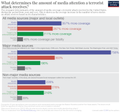English: Terrorism receives media attention which is disproportionate to its frequency and share of deaths. This is also the intention of terrorists. Fear and attention is, after all, a core tactic of terrorism: media covering the attack is a key part of the terrorist’s strategy. Terrorists are rarely successful at hijacking airplanes anymore. But they are very successful hijacking global news cycles.
But media coverage of terrorism is also highly unequal: some events receive a lot of attention while most receive very little.
Which are the characteristics that influence whether an attack is covered in the media or not? A previous study which looked at terrorist attacks in the US from 1980 to 2001 found they received more attention if there were fatalities; airlines were a target; it was a hijacking; or organized by a domestic group. Incidents received less coverage if they are framed as a crime (akin to homicide rather than terrorism, for which there is not always a clear boundary).
What does this relationship look like post-9/11? In a recent study, researchers looked at the differences in media coverage of terrorist events in the US from 2005 to 2015. Kearns et al. (2019) focused on three key characteristics: who the perpetrator was; the target of the attack; and the number of people killed. They assessed how these factors affected the amount of coverage attacks received in the US media.
We’ve summarized the results of their analysis in this visualization. It’s presented in three panels: for all media outlets (top); for major national news sources only (middle); and ‘non-major’ sources (bottom). In this study the authors define five major news sources as CNN.com, the New York Times, Wall Street Journal, the Washington Post and USA Today. ‘Non-major’ sources are thousands of local news outlets.
What’s striking is the much larger coverage if the perpetrator was Muslim. Across all media sources, attacks received on average 357% greater coverage if the attacker was Muslim; for major outlets this was higher still at 758%. It appeared to play less of a role for local outlets. From this analysis we also see that media coverage was higher when the perpetrator was arrested (partly because an arrest is a reportable event in itself); the target of the attack was law enforcement or government; and when people were killed in the attack. One additional fatality meant an average increase of coverage by 46%.
Which events do and do not receive media coverage matter: evidence shows that media plays a defining role in shifting public opinion; perceptions of the importance of particular issues; and national policy conversations. It can have a significant impact on how the public perceives terrorism and its associations.
In particular, increased coverage when a perpetrator is Muslim presents an unbalanced overview of US terrorism to the public. In the dataset that this study relied on, Muslims perpetrated 12.5% of attacks in the US, yet received half of the news coverage.
Combined with the fact that terrorism in general gets a disproportionate amount of media attention, the fact that the worst attacks – those that cause the greatest number of deaths – get most attention further exacerbates public fear. But it does mean that it’s not just terrorism that receives a lot of attention; it’s the rare but most extreme events that become easiest for us to recall.



